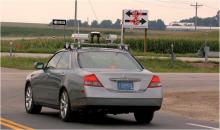
Michael Schagrin and Raymond Resendes provide an update on the US Department of Transportation's vehicle-to-vehicle programme.
TheIntelliDrive also sponsors research and other activities to support future connectivity among Vehicle-to-Infrastructure (V2I) and Vehicle-to-consumer Devices (V2D) to deliver safety and mobility benefits.
Research conducted by USDOT and the automotive industry has concluded that safety systems based on inter-vehicle communication offer the potential to significantly improve the effectiveness of crash avoidance and crash mitigation systems while lowering their cost.
USDOT recently developed a five-year research plan required to accelerate deployment of V2V-based safety systems. The plan was developed based on input from the automotive industry and other stakeholders, including 130 participants in a workshop held in Ypsilanti, Michigan in March 2009. The research plan identifies the interrelated research activities needed to resolve technical and policy issues. A similar effort is also underway to develop a five-year research plan for V2I safety systems, with an industry workshop being planned for later this summer.
The research plan is based on the following key assumptions: safety is the primary objective of the V2V capability, and V2V applications can address up to 95 per cent of crash scenarios; the need for infrastructure to support the security requirements for V2V Safety Applications is dependent on the deployment scenario, and requires further study; the system architecture for V2V will be compatible with the evolution in V2I technology and deployment, and this will allow for future upgrades that could provide additional safety benefits, and; at present, Dedicated Short-Range Communications (DSRC) remains the only available technology that meets the extremely low latency (fast transmission) and security requirements of active safety applications.
Since 2002, USDOT has been conducting research with automotive manufacturers (
The development of these applications was critical to understanding the functional and performance requirements for the underlying technologies, such as positioning and communications. However, additional work needs to be done to address more complex crash scenarios for head-on collision avoidance, intersection collision avoidance, pedestrian crash warning, and extending the capabilities to prevent motorcycle crashes. These capabilities could be achieved by providing V2V communication capabilities to complement other vehicle-based safety technologies.
The V2V Safety Applications Research Plan defines six major activities, or tracks, which are required to accelerate deployment of V2V:
Track 1 - Crash scenario framework
Research objectives are to: further define the crash problem; establish requirements and specifications for priority crash avoidance applications; and select priority safety applications for prototype development.Track 2 - Interoperability
In order to ensure that safety applications work in all equipped vehicles, common standards and protocols will be established for V2V systems. Specific objectives are: to develop communications standards and protocols; security protocols; positioning capabilities; messaging protocols; data rights; and privacy policies.Track 3 - Benefits assessment
The key objective is to develop a methodology for estimating the safety benefits of V2V applications, including performance measures and objective test procedures. Applications that are found to have valid safety benefits will be considered for the consumer information programmes process.Track 4 - Application development
Selected safety applications identified as the result of Track 1 activities will be developed into safety application prototypes.Prototypes will be evaluated using the safety benefits assessment methods developed in Track 3.
Track 5 - Driver issues
Researchers will assess the effectiveness of driver interfaces, including: whether drivers understand the systems; if the systems lead to appropriate driver reactions; and if drivers accept the systems.Track 6 - Policy
The policy-related issues that are critical to successful deployment, such as privacy and management of security certification, will be studied to ensure that the unique aspects of V2V are addressed within the global perspective of IntelliDrive. The V2V for safety research plan is the first of several that USDOT is developing for IntelliDrive program components. Other roadmaps are addressing V2I for safety; V2I for mobility; and policy.
More information about the V2V programme and IntelliDrive is available at http://www.intellidrive.org
Michael Schagrin is Project Lead for the IntelliDrive programme in the ITSJoint Program Office of the









